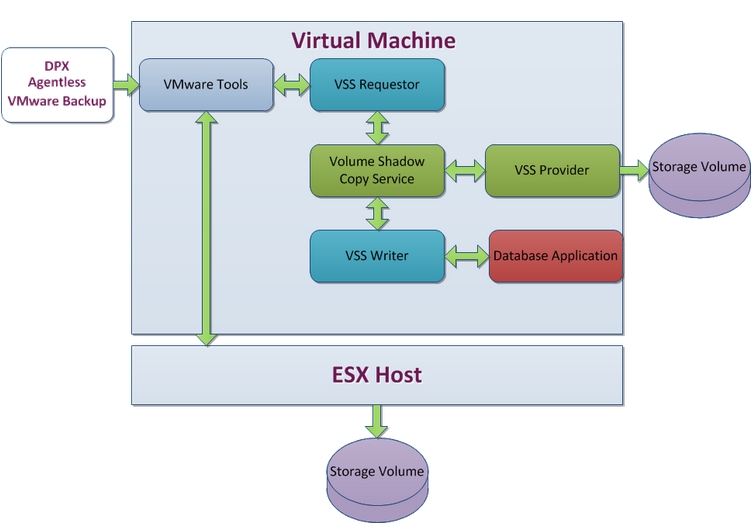Application-Consistent Protection
An Agentless VMware Backup with the file system and application quiesce option enabled allows Catalogic DPX to quiesce the source VM and generate an application-consistent backup, as opposed to a crash-consistent backup that is generated when the quiesce option is not enabled. A crash-consistent backup is equivalent to the VM losing power; the image consists of all of the VM’s data at the point the backup was taken. Crash-consistent backups restore the VM in the same state when the backup was taken. Crash-consistent backups do not capture pending transactions that are in memory, but not yet written to disk; database applications with pending transactions can lose those transactions after the crash-consistent backup is restored.
Application-Consistent backups allow applications that rely on databases to be properly backed up. Using Agentless VMware Backups with the file system and application quiesce option enabled allows application-consistent backups by quiescing the VM, thereby, placing the entire VM file system in a backup-ready state. The quiesce option allows Catalogic DPX to create a transactionally consistent backup of a VM running VSS-aware applications such as Active Directory, SQL Server, Exchange, and Sharepoint, without shutting them down.
Catalogic DPX uses VMware tools that direct the Microsoft VSS to invoke the snapshot process and quiesce the VSS-aware applications. VSS interfaces with the applications and Windows OS to quiesce all of the transactions at a specific point in time. The triggering of VSS writers starts a VSS freeze and halt the transactions of the database application to create a consistent view of application data before taking a VM snapshot. Using the VSS writer, the data for the application is in the same state as if the application was closed normally. This ensures that there are no unfinished database transactions or incomplete application files during backups.

Catalogic DPX provides additional application-aware agent-based protection for situations where additional granular application-level recovery is desired, such as restoring a specific SQL Server table instead of the entire VM. Agent-based backups are also recommended for VMs that have been uniquely configured for optimized performance of specific applications or require direct storage access. Application-aware agent-based backups are supported for Oracle, SharePoint, SQL Server, and Exchange. This protection is offered through the Catalogic DPX Block Data Protection and cannot be used through Agentless VMware Backup. Any VMs that manage these programs require the Catalogic DPX Client to be installed.
Determining the Consistency State of a Snapshot (desktop interface only)
On the Restore window, the application and file consistency state of a snapshot is indicated as follows:
![]()
The blue dot indicates that Catalogic DPX has verified the snapshot as file system and application-consistent.
![]()
Indicates that Catalogic DPX is unable to confirm the consistency state of the snapshot. Possible reasons include the ineligibility of the VM or the consistency state have not been recorded due to the age of the snapshot.
Last updated